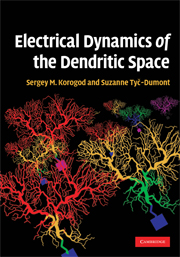Book contents
- Frontmatter
- Contents
- Preface
- 1 Definition of the neuron
- 2 3D geometry of dendritic arborizations
- 3 Basics in bioelectricity
- 4 Cable theory and dendrites
- 5 Voltage transfer over dendrites
- 6 Current transfer over dendrites
- 7 Electrical structure of an artificial dendritic path
- 8 Electrical structure of a bifurcation
- 9 Geography of the dendritic space
- 10 Electrical structures of biological dendrites
- 11 Electrical structure of the whole arborization
- 12 Electrical structures in 3D dendritic space
- 13 Dendritic space as a coder of the temporal output patterns
- 14 Concluding remarks
- Index
- References
8 - Electrical structure of a bifurcation
Published online by Cambridge University Press: 03 May 2010
- Frontmatter
- Contents
- Preface
- 1 Definition of the neuron
- 2 3D geometry of dendritic arborizations
- 3 Basics in bioelectricity
- 4 Cable theory and dendrites
- 5 Voltage transfer over dendrites
- 6 Current transfer over dendrites
- 7 Electrical structure of an artificial dendritic path
- 8 Electrical structure of a bifurcation
- 9 Geography of the dendritic space
- 10 Electrical structures of biological dendrites
- 11 Electrical structure of the whole arborization
- 12 Electrical structures in 3D dendritic space
- 13 Dendritic space as a coder of the temporal output patterns
- 14 Concluding remarks
- Index
- References
Summary
After the single dendritic path analyzed in the preceding chapter, an elementary bifurcation introduces the simplest case of a second discrete dimension for navigating over the dendrites. A set of elementary bifurcations forms the so-called binary tree, which is most typical for dendritic arborizations of neurons. Obviously, the bifurcation, also named binary branching or dichotomic branching is topologically symmetrical but most often metrically asymmetrical, due to differences in lengths and/or diameters of the sister branches.
In this chapter, we study the proximal-to-distal electrical relationship in two sister paths by comparing sites situated at the same path distance from their common origin but on different paths. The path length of the shorter branch determines the path distance extent of the domain in which we can compare equidistant sites, since it is obvious that the most distal sites on the longer branch do not have equidistant counterparts on the shorter one! Remaining at the same path distance from the origin in the first continuous dimension and ‘jumping’ from one branch to the other in the second discrete dimension, we can compare electrical states of equidistant sites (Figure 8.1). Such a structure is most convenient for studying the impact of the metrical asymmetry of branching on the electrical structure of the paths. The difference in the electrical states reveals the critical impact of metrical asymmetry.
Theory for different configurations
Consider a simple example of metrical asymmetry: two branches of the same diameter d and different lengths, shorter l and longer l′ = l + Δl (Δl > 0) arising from the common origin.
- Type
- Chapter
- Information
- Electrical Dynamics of the Dendritic Space , pp. 95 - 112Publisher: Cambridge University PressPrint publication year: 2009



